Isabella Bradford's Blog, page 52
July 21, 2016
Friday Video from the Archives: Dance Crazes of the Roaring Twenties
Isabella reporting,
Because I'm in New York today on a museum-and-research junket, I'm dipping back into our archives for some summertime dancing.
The 1920s may have been a decade of great change and historical significance, but on film, the '20s sure look like a whole lot of fun. This clip is a compilation of popular dances and general shenanigans from the time, matched to the appropriate music that's guaranteed to make you want to jump up for a quick Charleston or Foxtrot. Ain't we got fun!
If you receive this post via email, you may be seeing an empty space or black box where the video should be. Click here to view the video.
Published on July 21, 2016 21:00
July 20, 2016
Guidance for the Gentler Sex 1835
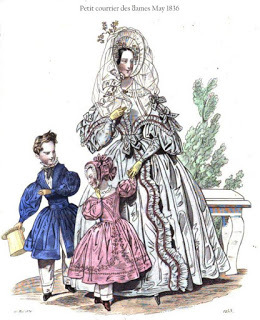 Family Fashions May 1836
Loretta reports:
Family Fashions May 1836
Loretta reports:Other than asking whether attitudes have changed—a little, a lot, not at all?—or whether these precepts ought to apply to men as well, I leave the commenting to my gentle readers.
~~~Female Temper. It is particularly necessary for girls to acquire command of their temper, because much of the effect of their powers of reasoning and of their wit, when they grow up, depend upon the gentleness and good humor with which they conduct themselves. A woman who would attempt to thunder with her tongue, would not find her eloquence increase her domestic happiness. We do not wish that women should implicitly yield their better judgment to their fathers and husbands, but let them support the cause of reason with all the graces of female gentleness.
A man, in a furious passion, is terrible to his enemies; but a woman, in a passion, is disgusting to her friends ; she loses all that respect due to her sex, and she has not masculine strength and courage to enforce any other kind of respect. These circumstances should be considered by those who advise that no difference should he made in the education of the two sexes.
The happiness and influence of woman, both as wives and mothers, and indeed, in every relation, so much depends on the temper, that it ought to he most carefully cultivated. We should not suffer girls to imagine that they can balance ill humor by some good quality or accomplishment; because, in fact, there is none which can supply the want of tenderness in the female sex.
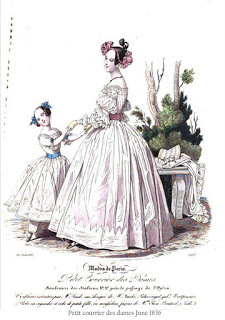 Mother & Daughter Fashions June 1836
Woman. It is in the middle rank of life that we behold woman in all her glory: not a doll to carry silk and jewels, a puppet to be dangled by coxcomb children, an idol for profane adoration; reverenced to-day, discarded to-morrow ; always jostled out of the true place which nature and society would assign her, by sensuality or contempt; admired but not respected; desired but not esteemed; ruled by fashion not affection ; imparted her weakness, not her constancy, to the sex she should exalt; the source and mirror of vanity.
Mother & Daughter Fashions June 1836
Woman. It is in the middle rank of life that we behold woman in all her glory: not a doll to carry silk and jewels, a puppet to be dangled by coxcomb children, an idol for profane adoration; reverenced to-day, discarded to-morrow ; always jostled out of the true place which nature and society would assign her, by sensuality or contempt; admired but not respected; desired but not esteemed; ruled by fashion not affection ; imparted her weakness, not her constancy, to the sex she should exalt; the source and mirror of vanity.
We see her as a wife, partaking the cares and cheering the anxiety of the husband; dividing his labors by domestic diligence, spreading cheerfulness around her; for his sake, sharing the refinements of the world without being vain of them ; placing all her pride, all her joy, all her happiness, in the merited approbation of the man she honors and loves.
As a mother, we find her the affectionate, the ardent instructress of the children she has tended from their infancy; training them up to thought and virtue, to meditation and benevolence, addressing them as rational beings, and preparing them to be men and women in their turn.
— The Ladies' Companion , Volumes 3-4, 1835
Published on July 20, 2016 21:30
July 18, 2016
Was the Perfect Desk Chair Made by the Shakers in 1860?
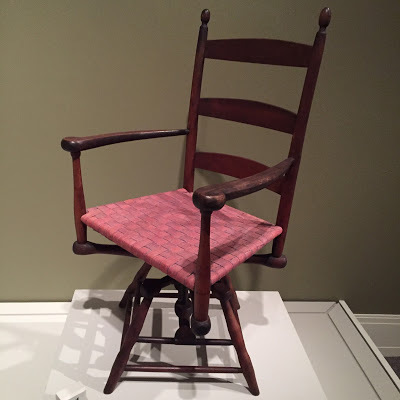 Isabella reporting,
Isabella reporting,Because so many of us writers spend so much of our time sitting at computers, finding the perfect office chair is often a popular topic of authorial conversations, and function always beats form in the pursuit of the most ergonomically perfect desk chair.
But apparently this quest is not new. The elegantly simple revolving armchair shown here, left, was designed and made by Shaker craftsmen c1860, and is now in the collection of Winterthur Museum . Here's the information from the placard:
The United Society of Believers in Christ's Second Appearing, also known as the Shakers, made seating furniture for sale to "outsiders" as well as a variety of forms for their own use. The purpose of this revolving armchair, one of only two known to survive, is unclear....A forerunner of the modern office chair, revolving armchairs such as this one may have been developed by a chairmaker at the Mount Lebanon Shaker community for commercial sale but was never put into production.
As innovators keenly interested in technological developments outside of their communities, the Shakers responded to patent rocking, tilting, and turning chairs that industrial designers were introducing for home and office use in the mid-19th century. The maker of this chair adapted Shaker practices to create a product that satisfied an aesthetic imperative for functional, mindful design; simplicity of form; and visual disclosure, rather than concealment, of structural elements.
Although it's nearly 150 years old, this chair with its swivel base and refined woodwork of maple and cherry looks surprisingly modern: "functional, mindful design," indeed. I'm betting that the seat made of woven tapes was probably pretty comfortable, too - though perhaps not comfortable enough for hours at the keyboard.
Of course, I have to bow out of the perfect desk chair discussion entirely, since I don't even have a desk. I write on a laptop on the bed. However, if someone offered me a Shaker chair....
Revolving armchair, probably made in Mount Lebanon, NY, c1860, Winterthur Museum.
Photograph ©2016 by Susan Holloway Scott.
Published on July 18, 2016 21:00
July 17, 2016
Proper Dress for Gentlemen in 1838
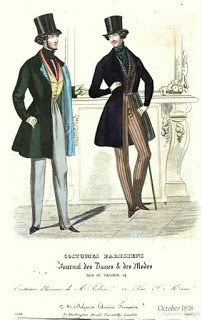 Men's Fashion Paris 1838Loretta reports:
Men's Fashion Paris 1838Loretta reports:I tried to cut this excerpt down to my preferred short post size. Unfortunately, unlike so much 19th century prose, this is fairly concise, as well as being enlightening on several points.
However ugly you may be, rest assured that there is some style of dress which will make you passable ...— Etiquette for Gentlemen, with hints on the art of conversation , 1838
If you have weak eyes, you should wear spectacles. If the defect be great, your glasses should be coloured. In such cases emulate the sky rather than the sea: green spectacles are an abomination—blue ones are respectable, and even distingué.
Almost every defect of face may be concealed by a judicious use and arrangement of hair. Take care, however, that your hair be not of one colour and your whiskers of another. If you wear a wig, let it be large enough to cover the whole of your red or white hair.
The style of dress for the street is of little consequence, so that it be in good taste. Very light-coloured coats are to be avoided, as well as any thing in strong contrast with the other parts of your dress. The effect of a frock coat is to conceal the height. If, therefore, you are beneath the ordinary stature, or much above it, you should affect frock coats on all occasions that etiquette permits.
In the dining-room, and the drawing-room, dress coats must be adopted, and of late boots are permitted; but shoes and silk stockings are in better taste.
Abroad, in public assemblies, in the church or the theatre, as well as in walking the street, you should always wear gloves. The greatest care should be taken that they fit well, and that they are scrupulously unsullied.
Before going to a ball or party it is not sufficient that you consult your mirror twenty times. You must be personally inspected by your servant or a friend. From want of this precaution, I once saw a gentleman enter a ball-room, attired with scrupulous elegance, but with one of his suspenders curling in graceful festoons about his feet. His glass could not show what was behind.
When we speak of excellence in dress we do not mean richness of clothing, nor manifested elaboration. Profusion of ornaments, rings, chains, &c. &c. are in bad taste. Faultless propriety, perfect harmony, and a refined simplicity,—these are the charms which always fascinate.
It is as great a sin to be finical in dress as to be negligent. A gentleman will always be well and tastefully dressed—choosing a sort of middle course between the extremes: avoiding foppery on the one hand, and carelessness on the other.
Upon this subject the ladies are the only infallible oracles. Apart from the perfection to which they must of necessity arrive, from devoting their entire existence to such considerations, they seem to be endued with an inexpressible tact, a sort of sixth sense, which reveals intuitively the proper distinctions. That your dress is approved by a man is nothing;—you cannot enjoy the high satisfaction of being perfectly comme il faut, until your performance has received the seal of a woman's approbation.Paris fashion June 1838
Images from Journal des Dames & des Modes, Costumes Parisiens, 1838. (Not a lot of men's 1830s fashion in any English publication I could find online.)
Clicking on the image will enlarge it. Clicking on the caption will take you to the source, where you can learn more and enlarge images as needed.
Published on July 17, 2016 21:30
July 16, 2016
Breakfast Links: Week of July 11, 2016
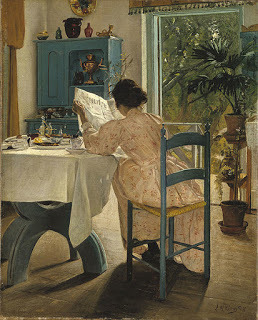 Breakfast Links are served - our weekly round-up of fav links to other web sites, articles, blogs, and images via Twitter.
Breakfast Links are served - our weekly round-up of fav links to other web sites, articles, blogs, and images via Twitter.• Victorian sewing : a brief history of plain and fancy work.
• Boxing with Byron.
• The heavenly strawberry : an earthly delight and symbol of summer.
• A breech-less brute .
• All for publicity: a 1940s abalone picnic on the beach.
• Video: short video featuring an embroidered, fringed velvet dress from the 1920s.
• Stunning 19thc photographs of Native American girls and women (scroll down past the ads; the images are worth it!)
• Killed by beer: the Meux brewery flood of 1814.
• The bloody history of the U.S. House of Representatives .
• A hound named Sweetlips belonged to George Washington: soldier, statesman, and dog-lover.
• For the flapper craving the perfect cupid's-bow lips: the lipstick template .
• The evolution of the kilt .
• Image: Fashion reality: 1912 Sourbet dress by Poiret beside fashion illustration of the same dress.
• Victorian sheet music covers .
• How a Portuguese-to-English phrasebook became a comedy sensation in the 1880s.
• A brief history of London's mulberries .
• Jack Daniel's embraces a hidden ingredient: help from a slave.
• Treasure of historic clothing revealed on the effigies of Westminster Abbey.
• The christening of Princess Victoria , June 24, 1819.
• Garden Bridge vs. Pier 55: why do New York and London think so differently about privately funded parks ?
• Image: It's 1861 - and you can read this entry in the journal of nine-year-old Bostonian Sarah Putnam to discover how she spent her day.
• Remembering Elizabeth Cary Agassiz , 19thc naturalist and educator.
• A town tries to care for, and let go of, its oldest resident: a 600-year-old oak tree .
• "My darling, au revoir": the World War One diaries of Captain Charles May.
• Hanging out at La Morgue in 19thc Paris.
• Image: Portrait of Emily Bronte by her brother Branwell.
• From Bunker Hill to "Gilligan's Island," Shakespeare has a special place in American culture.
• It's a bird, it's a plane, it's a monster - or the 1880s Coney Island Flying Man .
• Rudyard Kipling wrote The Jungle Book in the last place you'd expect: Vermont.
• Image: Gloriously euphemistic 1939 advertisement for maternity clothing .
• The circus comes to Newburyport MA in 1810 - and upright people are scandalized.
Hungry for more? Follow us on Twitter @2nerdyhistgirls for fresh updates daily.
Above: At Breakfast by Laurits Andersen Ring. Private collection.
Published on July 16, 2016 14:00
July 14, 2016
Friday Video: The True Truth About Corsets
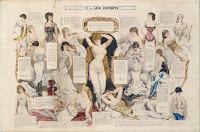 Corsets
Loretta reports:
Corsets
Loretta reports:Isabella/Susan and I have devoted quite a bit of blog space to dealing with corset myths. Here , for instance. (For more, please search “corsets” on this blog.) However, we are only two nerdy history people against a tsunami of myths.
In an essay in a May issue of the New Yorker , the writer referred to women removing ribs to make their waists smaller as an example of how women torture themselves for fashion. We addressed this rib-removal urban legend in our myth-busting talk last spring at the New England Romance Writers Conference, and will no doubt address it again. The short version: No one has yet found a shred of actual medical evidence to support this; the evidence against, on the other hand, is substantial.
Meanwhile, here’s some footage to help bust the myth about Victorian ladies languishing on their sofas (when they weren’t too busy fainting, that is).
And you might want to check out her blog post here .
Image: Henri de Montaut, Etudes sur les femmes 1882-1890, courtesy Metropolitan Museum of Art, The Elisha Whittelsey Collection, The Elisha Whittelsey Fund, 1951.
Readers who receive our blog via email might see a rectangle, square, or nothing where the video ought to be. To watch the video, please click on the title to this post.
Published on July 14, 2016 21:30
July 13, 2016
From the Archives: Tambour Work Embroidery, 1730-1840
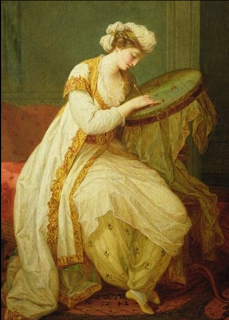 Isabella reporting,
Isabella reporting,After my post on Monday featuring knotting as an 18thc lady's pastime, I thought I'd bring back this post featuring another once-popular form of handwork: tambour embroidery.
Although the origins of tambour embroidery are a bit hazy, it appeared in Europe in the 18th c. and quickly became a popular "accomplishment" for ladies. It was considered exotic stitchery, which contributed to its popularity, and many of the finest commercial examples were imported to Britain and France from India and Persia. The rather fanciful portrait of an 18th c. Turkish lady (or more likely a French lady in Turkish dress), left, shows her working tambour embroidery on a large hoop tambour frame.
There is only one stitch to master in tambour embroidery. Instead of a needle, very fine, sharp hook is punched through a tightly stretched fabric to catch a fine thread from beneath and draw it up, creating a linked, chain-like stitch. The name "tambour work" comes from the way the fabric is held taut between two round, fitted hoops, resembling the head of a small drum, or tambour. (Demonstrating tambour work, below left, is our friend Janea Whitacre, mantua-maker from Colonial Williamsburg .)
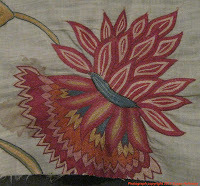
A pattern was usually marked on the fabric, to be followed by the embroiderer, and designs were commercially available. Because the thread is continuous, a practiced worker could stitch more rapidly than by other traditional embroidery methods. It also required less concentration, which made it perfect for being industrious while socializing with friends. The finished work could be almost lacy – a popular effect when working with white thread on a white fabric – or dense with shades of color. By working rows of chained stitches closely together, it was possible to achieve beautifully shaded colorwork with a great deal of depth and subtlety, such as in this fragment, upper right.
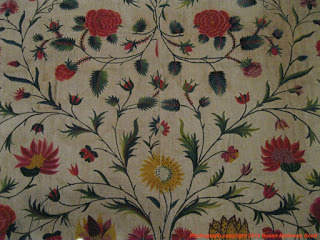
With its single rows of chained stitches, the Hedge House petticoat border was likely the work of an industrious amateur, a lady proudly enhancing her own clothing. Much more elaborate tambour work was produced by professional embroiderers, to be made up into fashionable garments by tailors and mantua-makers. Sometimes this embroidery was done to a specific size, like the front of a gentleman's waistcoat, while other examples show an entire length of cloth covered with embroidery to achieve an overall pattern. The detail of the petticoat, lower right, shows how two such lengths were stitched together.
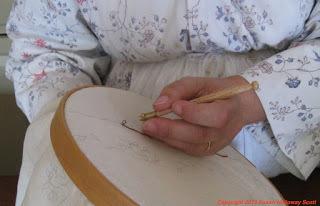 While tambour work embroidery was wildly popular from the mid 18th c. through the early 19th c., needlework goes in and out of fashion like everything else. In 1834, a French machine was introduced that could reproduce tambour-style embroidery at a rate 140 times faster than a woman working by hand. The commercial embroiderers vanished, and the ladies who were the amateur tambour workers were developing other interests as well. Victorian tastes shifted away from delicate needlework to the less demanding Berlin work in wool on canvas, and by the 1840s, tambour work was relegated to something your grandmother used to do, and was virtually forgotten.
While tambour work embroidery was wildly popular from the mid 18th c. through the early 19th c., needlework goes in and out of fashion like everything else. In 1834, a French machine was introduced that could reproduce tambour-style embroidery at a rate 140 times faster than a woman working by hand. The commercial embroiderers vanished, and the ladies who were the amateur tambour workers were developing other interests as well. Victorian tastes shifted away from delicate needlework to the less demanding Berlin work in wool on canvas, and by the 1840s, tambour work was relegated to something your grandmother used to do, and was virtually forgotten.Top left: A Turkish Woman, by Angelica Kauffmann, 1773, The Pushkin State Museum of Fine Arts, Moscow.
Top right: Fragment of Tambour Work, India, 1700-1800, silk on cotton. Winterthur Museum.
Lower right: Tambour Petticoat, France, 1700-1750, wool on linen. Winterthur Museum.
Bottom left: Photograph of Tambour Work, by Susan Holloway Scott.
Published on July 13, 2016 21:00
July 11, 2016
Gothic Library for July 1813
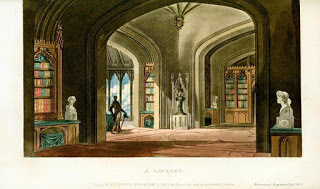 Gothic Library July 1813
Loretta reports:
Gothic Library July 1813
Loretta reports:I tend to set many scenes in libraries, for all kinds of reasons. Libraries in great houses can be cozy or vast. By the Regency, and certainly by the time of my stories, people are spending more time in them, reading, looking at maps, drawing, writing letters, or simply using it as a family den—“a room of usual resort” as the description puts it. In my searches online, I’ve found libraries of all shapes and sizes. They might contain a greater variety of furniture than other rooms. And then, I like the idea of surrounding my characters with books.
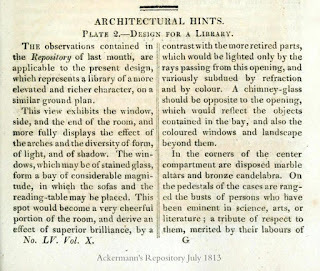 Library description
This gothic-looking library is a follow up to the previous month’s architectural feature You can read the “observations contained in the Repository of last month”
here
.
Library description
This gothic-looking library is a follow up to the previous month’s architectural feature You can read the “observations contained in the Repository of last month”
here
.The image, not as interesting, I think, as July’s, is here .
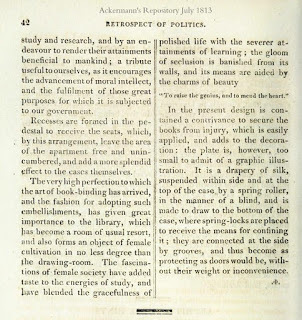 Library description cont'd
Library description cont'd
Clicking on the image will enlarge it. Clicking on the caption will take you to the source, where you can learn more and enlarge images as needed.
Published on July 11, 2016 21:30
July 10, 2016
Handwork for 18thc Ladies: A Beautiful Knotting Shuttle
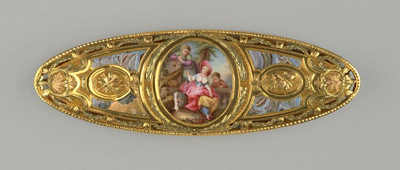
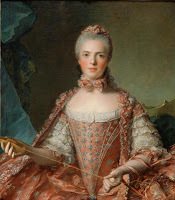 Isabella reporting,
Isabella reporting,As a habitual knitter and needleworker, I have great empathy for the 18thc ladies who chose to have their portraits painted doing the handwork of their choice, whether sewing, needlepoint, embroidery, knitting, tambour-work, netting, or knotting. Of course, in these paintings the handwork wasn't perceived in modern terms as a hobby or as creative self-expression, but as a symbol of feminine industry and domesticity. It was also considered an attractive way to display graceful hands and wrists (something I'll admit I don't begin to consider while I knit.)

Knotting was favored by aristocratic ladies of the French court, such as Madame Adélaïde, above left, the daughter of Louis XV and Marie Leszczynska. (As always, please click on the image to enlarge it.) The thread was knotted at close intervals to create a decorative braid that could then be stitched onto clothing or other items. Silk thread or cord was wrapped around a shuttle, and unwound as needed.As handwork and needlework go, it's not complicated.
Elegantly industrious displays in the drawing room required decorative tools, too. I spotted this 18thc knotting shuttle, top and right, last week on Twitter, and it's a beauty. Knotting shuttles were often made of expensive materials such as tortoiseshell, crystal, mother-of-pearl, and silver. This one must have been top-of-the-line, for it's gold. Delicate enamel work adds further embellishment, with a rural scene as well as simulated stone inlay, detail lower left. This shuttle falls into the same category of luxurious small-goods pretending to be useful such as jeweled snuffboxes, gold boxes for rouge, and enameled nécessaires - costly little indulgences that the skilled tradespeople of 18thc Paris were so talented at creating.
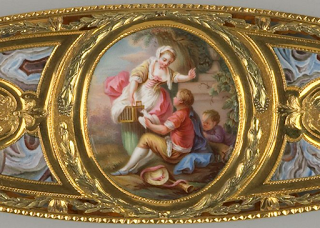
Still, it's easy to imagine an indulged, aristocratic Parisienne, dressed in silk and lace with her hair perfectly powdered, making witty, flirtatious conversation along with her silk knots as her golden shuttle flashes back and forth....
Above: Shuttle, mid-18thc, French, Wallace Collection.
Left: Madame Adélaïde de France Tying Knots by Jean-Marc Nattier, 1756, Château de Versailles.
Published on July 10, 2016 17:00
July 9, 2016
Breakfast Links: Week of July 4, 2016
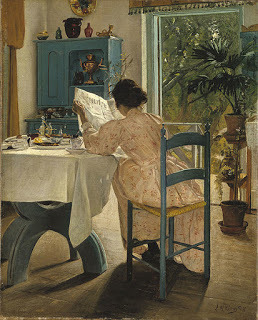 Breakfast Links are served - our weekly round-up of fav links to other web sites, articles, blogs, and images via Twitter.
Breakfast Links are served - our weekly round-up of fav links to other web sites, articles, blogs, and images via Twitter.• A dinosaur dinner, and and relics from "one of the greatest humbugs , frauds, and absurdities ever known."
• The Major Oak , capturing the imagination for centuries.
• The naked truth about French postcards .
• Mabel Loomis Todd , the adulteress who made Emily Dickinson famous.
• Taming a scaly sphinx - and making it into a fabulous jewel.
• Scott and Zelda document their lives: Fitzgerald scrapbooks now online.
• Video: Pineapples and frogs: a selection of whimsical purses from the Museum of London.
• Be-neaped and beating the booby: talking like a sailor , 1867.
• Some of history's most beautiful combs were made to remove lice.
• Samuel Pepys at St. Olave's
• The last ruins of Dunwich, Suffolk's lost medieval town .
• Educated fleas , health-giving beer, and sweet-smelling elephants: highlights from American pamphlets, 1820-1922.
• The secret messages hiding inside 17thc engagement rings .
• The Devil's Column at the Basilica Sant'Ambrogio.
• Image: Letter written in 1842 with the question " What's up ?"
• "The frightful consequences of self-pollution": Why has masturbation historically been a shameful fact of life?
• Black women featured in early modern cameos .
• Meet the woman who preserves the vintage clothing in the collection of the Metropolitan Museum of Art.
• Image: Did you know that Amelia Earhart also had a successful clothing line?
• Thousands of early 20thc art posters available to download for free from the New York Public Library.
• Paris , the big picture.
• An old Maryland recipe for vanilla ice cream , plus why the food of the past wasn't always better.
• The Bromley Wizard and the cheese kettle .
• The Glastonbury Cows and the fight for women's suffrage .
Hungry for more? Follow us on Twitter @2nerdyhistgirls for fresh updates daily.
Above: At Breakfast by Laurits Andersen Ring. Private collection.
Published on July 09, 2016 17:10



